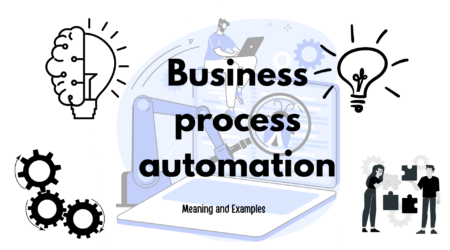Business automation refers to the fusion of contemporary application development with business process management (BPM) and business rules management (BRM) to address the needs of a dynamically changing market.
The Key To Success
The key to flourishing in the current market climate is digital transformation, which calls for collaboration between business and IT executives.
Automation has impacted practically every industry throughout the years, from healthcare to assembly lines and ATMs. Automation is being raised to a whole new level by machine learning and artificial intelligence (AI).
Human-machine interaction is evolving because of so-called “intelligent automation,” which enables companies to operate more profitably, more efficiently, and in competitive marketplaces.

What Is Business Automation?
Business automation refers to the use of software programmes to automate monotonous operations so that personnel may focus on higher-value work. This comprises AI-powered automation, robotic process automation, and business process automation (BPA).
Automation used to require enormous mainframes and a staff of specialists to manage them. These days, enterprises of various sizes may access the capabilities thanks to cloud-based automation tools. Following are some examples of business automation:
Marketing Automation:
Marketing is a crucial corporate function that may be time-consuming and expensive, making automation a viable option for simplicity.
Companies may produce highly qualified leads that are prepared for sales engagement using marketing automation technologies, which often take the form of software.
Additionally, these technologies offer a framework for teams to target, create, implement, and assess the performance of marketing campaigns, simplifying the lead qualifying and conversion process.
Email Marketing Automation :
Email marketing procedures may be automated by some marketing automation software, enabling businesses to better coordinate these campaigns with the work of their sales staff.
Additionally, businesses may follow and evaluate a prospect’s activities using marketing automation technologies, determine when a lead satisfies recognized buyer-readiness criteria, and forward leads to sales as soon as they do.
All sizes of businesses may benefit from marketing automation. For instance, a smaller business can use the programme to create, produce, and send out monthly emails to a customer distribution list with pertinent information or offers.
This process can significantly reduce the number of hours spent on customer “touches” over the course of a year.
A bigger company, on the other hand, could seek to benefit from more advanced marketing automation capabilities, such as the dynamic segmenting of a sizable customer database, the targeting of consumers with automated messaging via social media and SMS, or specially designed workflows that complement the firm’s unique marketing procedures.
Companies may save the cost of creating and maintaining internet marketing and lead generation initiatives by automating these activities. This, in turn, helps to create a higher measurable return on investment (ROI) for each of those campaigns.
Accounting And Bookkeeping Automation
It’s crucial to keep in mind that accounting as a function has always embraced technology as corporate communication and transactions go online. The effectiveness of automation in bookkeeping and accounting procedures has been established.
The majority of mathematical operations involved in bookkeeping and accounting need time, focus, and human error. Automation of simple but crucial bookkeeping chores may significantly lower data entry mistakes.
To handle repetitive jobs and those requiring a lot of data entry, automation can be tailored. Consequently, compared to human calculations, these automated calculations and calculations utilizing accounting data are more precise and therefore more dependable.
Alternatives :
Consider all of your alternatives carefully when trying to automate bookkeeping and accounting tasks. Think carefully about which chores should be automated and to what degree. The advantages of automation are most effectively tapped when software is cleverly applied to certain activities, satisfies business requirements, and lowers costs.
It’s possible that you’ll be disappointed if you just download a tool without considering how it matches your automation objectives.
Opting The Best Automation Features :
Choosing the appropriate features to automate is a crucial part of automated accounting, even if the demands of the business, its size, clients, vendors, and other criteria like the products and services supplied ultimately determine how much bookkeeping automation is necessary.
Your specific company requirements will determine how you proceed. For instance, digitizing every company receipt may ease the workload on staff while guaranteeing that transactions are accurately documented and receipts are not lost. The same is true of billing.
Through effective ledger management, automated invoicing can contribute to better financial management. By automating invoicing, payment processing may start as soon as the task is finished. When using manual processes, invoicing may be delayed, which extends the aging of the accounts and increases the number of accounts receivable (AR).
Process Automation
Business process automation (BPA) expands on simple automation by integrating several applications to help businesses increase productivity and value. Robotic process automation (RPA), a subset of business process automation (BPA), focuses on automating repetitive processes while BPA helps businesses maximise their automation investments.
BPA accomplishes this by combining data from several sources to provide analyses that would be challenging to complete manually.
Companies Are Using BPA For Functions Like:
- Automated order entry
- Email automation
- Automated batch processing
- Automated file transfers
- Automated report generation and distribution
Nearly every aspect of a business’s operations, from recruiting to email management to accounting, would benefit from BPA, which not only eliminates manual labour but also streamlines and enhances the workflow phases that make up the process.
An entire step in the current workflow, such as email chains and document transfers, is removed when a business process is automated.
HR Automation
A multi-step process, hiring new employees begins with an online job ad or recruitment attempt and culminates with the person being formally onboarded. This procedure has several phases that can be automated.
In order to achieve this, a human resources management system (HRMS) is a useful tool. These systems automate the candidate management process as a component of a wider range of functionality.
This especially applies to automated employment offers that are given to prospects directly, which helps advertise open positions to both the public and current workers who might want to submit an application for an internal position or recommend individuals.
An HRMS is useful for businesses where the candidate experience is a top priority—from applying to managing resumes to scheduling interviews to making offers.
Due to the fact that HRMS automates all aspect of human resources administration, including payroll and onboarding, it offers comprehensive analytics for these procedures. Additionally, it automates key HR procedures like scheduling leave for employees and administering benefits.
These technologies also offer crucial insights on the effectiveness and productivity of a company’s staff using analytics.
Software can manage the following additional HR tasks:
- preservation and retrieval of employee records.
- examinations of internet applications for jobs.
- Work contracts, confidentiality agreements, waivers, and other new hire paperwork are distributed and signed.
- managing employee tax forms.
- prerequisites for training (e.g., when an employee moves into a new position).
- eligibility for benefit enrollment.
Conclusion :
Businesses used to be able to boost productivity and reduce expenses throughout the organization by simply automating procedures. BPM and BRM were significantly responsible for achieving this. Although BPM and BRM are excellent technologies, they are no longer sufficient on their own.
ALSO READ
You may also like our other related articles on automation :







